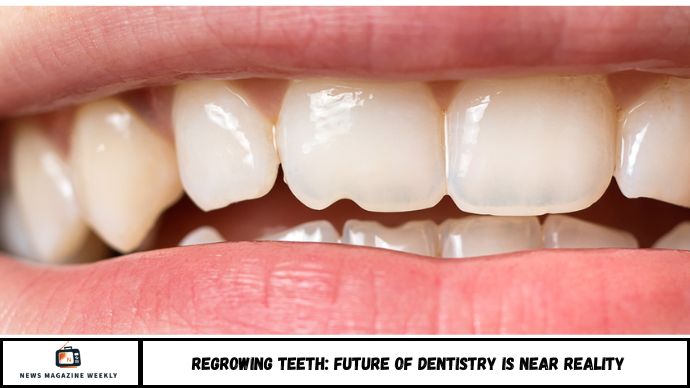Regrowing Teeth Is on the Horizon and May Represent the Future of Dentistry
Tooth regeneration is no longer just science fiction. Researchers are making real progress toward regrowing human teeth, a breakthrough that could revolutionize modern dentistry. This article explores the current science, clinical trials, and what this innovation means for tooth loss, dental care, and the future of oral health.
This once-unthinkable idea is rapidly becoming a scientific reality. In a world where over 2.5 billion people suffer from untreated tooth decay, traditional dental treatments like crowns, bridges, and implants often fall short of restoring full tooth function. Now, thanks to groundbreaking research in stem cell therapy and regenerative medicine, scientists are working on ways to regrow human teeth from scratch.
What If You Could Grow Back a Lost Tooth?
Imagine losing a tooth—and instead of getting a crown or implant, your body simply grows a new one.
This scenario may soon become a reality.
For decades, tooth loss has been treated with fillings, dentures, or dental implants—expensive, sometimes painful solutions that don’t fully replicate a natural tooth. But thanks to breakthroughs in regenerative medicine and dental stem cell research, tooth regrowth may soon be possible.
This article will cover:
- How scientists are developing real tooth regeneration
- Why this matters for people with tooth loss or decay
- The latest research, clinical trials, and projected timelines
- What this means for the future of dentistry
The Science Behind Tooth Regeneration
Tooth development is governed by complex biological signals, which researchers have begun to decode. Much of the current research focuses on stimulating the body’s natural ability to grow teeth, especially by activating dental lamina, a tissue involved in early tooth development.
Key Scientific Developments:
- Dental stem cells: Found in the pulp of baby teeth and adult molars, these can regenerate dentin, enamel, and pulp under the right conditions.
- Gene therapy: Researchers are testing ways to “turn on” tooth-forming genes that are inactive in adults.
- Animal studies: Japanese scientists successfully regrew fully functional teeth in mice and ferrets, and human trials are planned for 2025.
Why This Matters: The Need for Natural Tooth Replacement
Globally, over 2.5 billion people suffer from tooth decay, according to the World Health Organization (WHO, 2024). Many deal with tooth loss due to cavities, trauma, or age-related issues.
Current limitations in dental treatments:
- Dental implants are costly and invasive.
- Dentures can be uncomfortable and require maintenance.
- Crowns and fillings don’t restore full tooth function or structure.
Tooth regeneration offers a natural, permanent solution—eliminating the need for artificial replacements entirely.
How Soon Will Regrowing Teeth Be Possible?
One of the most promising studies comes from Kitano Hospital in Japan, where scientists developed a drug that stimulated third tooth development in animals. Clinical trials on humans are scheduled to begin in 2025, with potential public availability by 2030 if successful.
Projected Timeline:
- 2025: Human clinical trials begin
- 2027–2029: Early treatments for specific conditions
- 2030+: Widespread access in dental clinics
Potential Applications of Tooth Regeneration
Tooth regrowth could benefit people with:
- Congenital tooth loss (hypodontia or anodontia)
- Tooth loss due to trauma or disease
- Worn-down or heavily decayed teeth
- Children who lose adult teeth prematurely
It could also reduce the need for root canals, extractions, and prosthetics, improving overall oral health outcomes.
FAQ
1. Can humans really regrow teeth naturally?
Not yet—but with new treatments, scientists aim to activate dormant tooth-growth pathways in adults.
2. When will tooth regrowth be available to the public?
If human trials go well, it could be available by 2030 in specialized clinics.
3. Is tooth regeneration safer than implants?
It could be safer long-term, as it’s based on natural biological processes, avoiding surgical complications.
4. Who qualifies for early tooth regrowth treatments?
Initial candidates may include people with congenital tooth absence or severe dental trauma.
5. Will insurance cover tooth regeneration procedures?
It’s too early to say, but as the technology becomes mainstream, coverage may expand.
6. Will kids or adults benefit more from this?
Both, though children with missing adult teeth may be the first to benefit.
Conclusion
The ability to regrow human teeth could represent the most profound change in dental care in over a century. What was once science fiction is becoming science fact—thanks to rapid progress in biotech, stem cell science, and genetics.
As clinical trials move forward, dentists and patients alike should prepare for a future where missing teeth are no longer permanent—but just temporary setbacks in a self-healing body.

